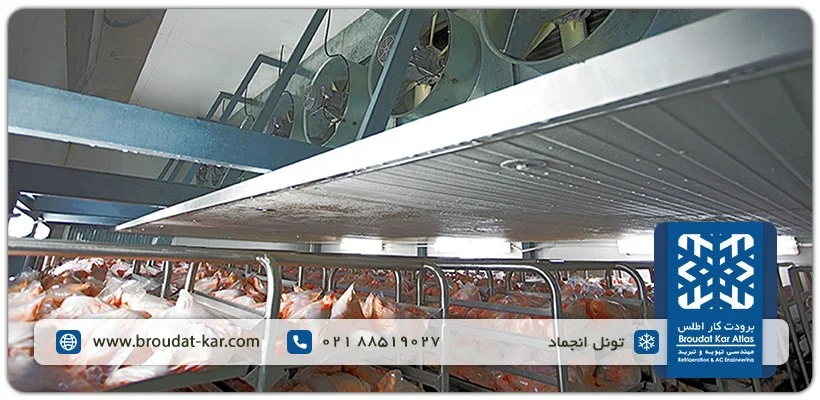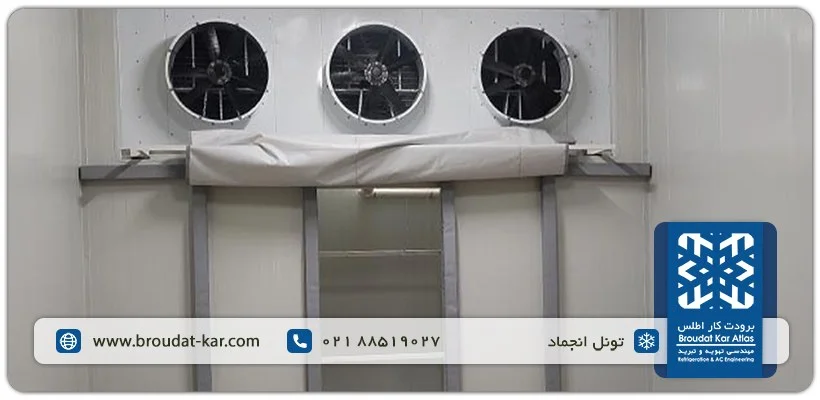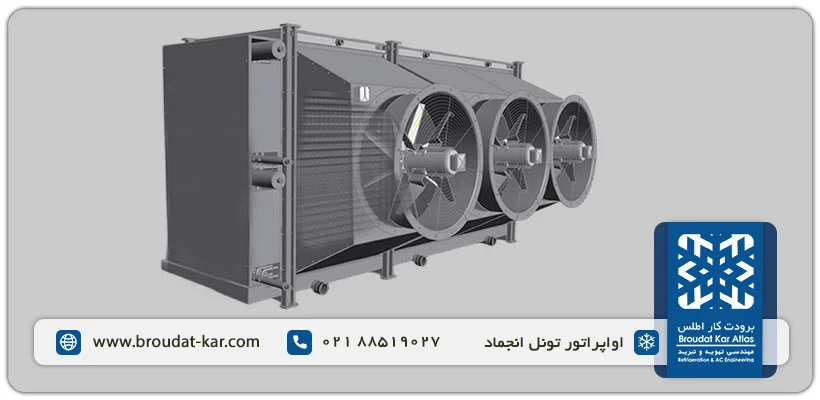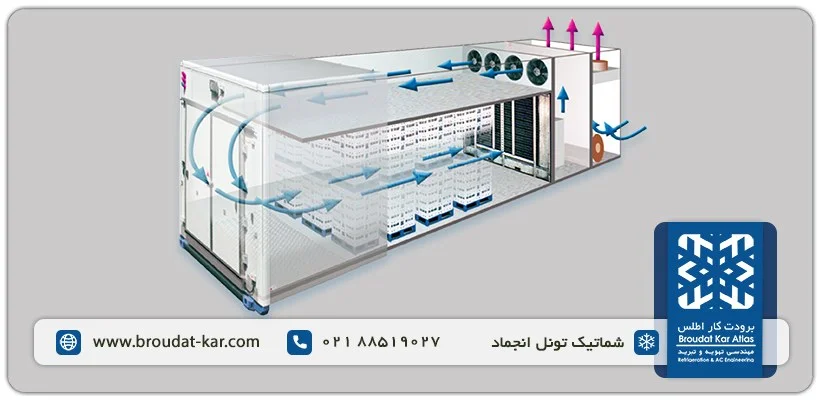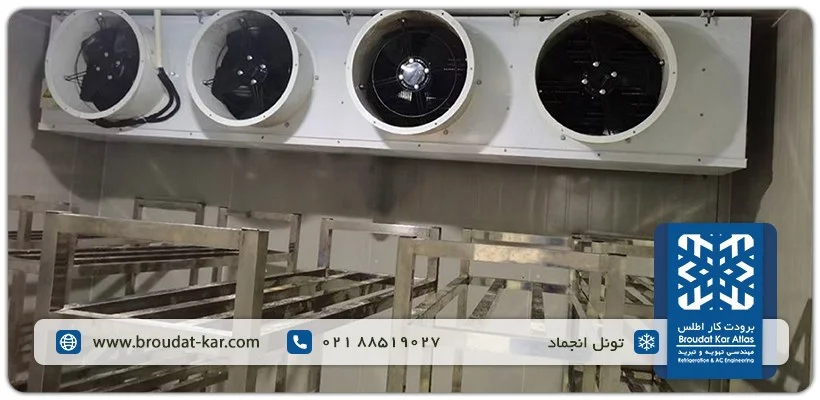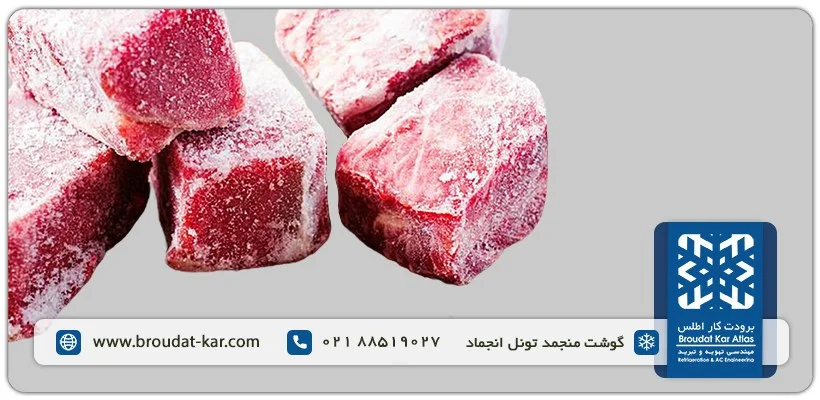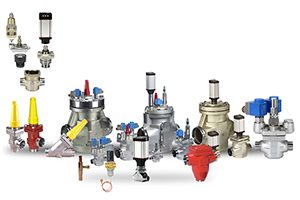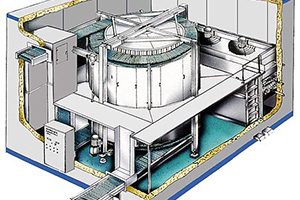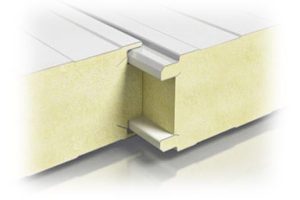What is Blast Freezer and How is it Used?
Atlas Refrigeration Co., Ltd. specializes in manufacturing and installing advanced blast freezers, also referred to as freezing tunnels. These specialized refrigeration systems are meticulously engineered to swiftly freeze substantial volumes of food products. Their mechanism involves the strategic amalgamation of high-speed air circulation and a low-temperature refrigerant, swiftly solidifying food items to safeguard their quality, consistency, and nutritional composition.
Operating at temperatures below -10°C, blast freezers significantly decelerate the proliferation of microorganisms. As the temperature drops to approximately -18°C, the growth of these organisms practically halts. In frozen food, the conversion of existing moisture into ice markedly diminishes the risk of bacterial proliferation, thus elongating the shelf life of the product. This meticulous freezing process actively combats spoilage, ensuring an extended preservation period for the food items.
Importance of Blast freezers in the Food Industry
Industrial blast freezers play a pivotal role in the food industry, offering indispensable advantages that aid food producers in meeting consumer needs while upholding stringent quality benchmarks.
Their significance stems from the ability to rapidly freeze substantial volumes of perishable food items. This is particularly critical for delicate goods like meat, seafood, fruits, and vegetables, which necessitate low-temperature storage to forestall spoilage. Leveraging blast freezers enables producers to drastically truncate the freezing duration for these foodstuffs, amplifying production efficiency and curbing product wastage significantly.
History of Blast freezer Usage
The integrity of food product cellular structures directly hinges on the pace of freezing. Slower freezing rates culminate in larger ice crystals within the product, prompting cellular rupture, altering the food’s appearance and flavor. Ergo, curtailing freezing duration ensures a higher quality frozen product. The genesis of blast freezers centers precisely on hastening freezing rates, swiftly solidifying a product’s core for prompt cold storage readiness.
In the 1950s, blast freezers surged in popularity for swiftly freezing substantial food quantities. This system harnessed high-speed cold air circulation, slashing processing periods and augmenting production efficiency. It played a pivotal role in preserving the quality, consistency, and nutritional profile of diverse food items, becoming a favored freezing technique.
The blast freezer is responsible for freezing products before they enter the sub-zero storage facility. These facilities freeze products at temperatures below -30°C using high-speed airflow. This technology was first introduced to the world in the 1920’s by Clarence Birdseye.
The evolution of refrigeration technology has birthed more sophisticated blast freezers, advancing freezing speeds and efficiency. For instance, the 1970s witnessed the advent of spiral freezers featuring a continuous conveyor belt system, revolutionizing the rapid freezing of vast food volumes, further enhancing freezing speeds and capacity.
Operation of Blast freezers
Industrial blast freezers are robust facilities specifically engineered for swiftly freezing substantial quantities of food items, employing cutting-edge refrigeration technologies. This section will delve into the fundamental principles governing blast freezer operations, delineate its distinct components, expound on the freezing procedure, and elucidate why its expeditiousness and efficacy outstrip conventional freezing methods.
Basic Principles of Freezing Operation
A Blast freezer harnesses the mechanism of forced convection, employing vigorous air circulation to swiftly freeze food products. This process involves directing high-speed airflow, typically maintained at temperatures ranging between -30 to -40 degrees Celsius, across the surface of the food items, rapidly lowering their temperature. High-speed fans within the Blast freezer draw cold air from the evaporator coil and ensure its uniform distribution throughout the space, facilitating the swift and even freezing of the food products.
Blast freezer Equipment
The primary components of a Blast freezer comprise the compressor, evaporator, condenser, and expansion valve. The compressor plays a pivotal role in compressing the refrigerant gas, elevating both its pressure and temperature. Subsequently, the hot, pressurized gas proceeds to the condenser, where it undergoes cooling, transitioning into a liquid state. This liquid refrigerant then travels towards the evaporator coil, where it expands, evaporates, and effectively absorbs heat from the adjacent environment. This process is integral to cooling the air within the Blast freezer.
In systems employing piston compressors, the use of two-stage compressors becomes imperative to leverage subcooling techniques for operation at temperatures as low as -40 degrees Celsius. Conversely, Blast freezer setups integrating screw compressors can achieve an evaporating temperature of -40 degrees Celsius in a single stage setup. Moreover, in a two-stage refrigeration system, one or multiple compressors function within the high-pressure circuit (-10 degrees Celsius), while another set operates within the low-pressure or booster circuit (-40 degrees Celsius). Both piston and screw compressors find application in these circuits.
Screw compressors, albeit pricier in comparison to piston compressors, boast advanced technology, heightened efficiency, superior performance, reduced moving parts, and consequently, streamlined maintenance and operation. Their adoption signifies a trade-off between initial investment and long-term benefits, offering enhanced efficiency and operational simplicity in Blast freezer systems.
Freezing Process
The freezing mechanism within the Blast freezer operates via the circulation of frigid air across the food product surfaces. Air, maintained at approximately -35 degrees Celsius, actively absorbs heat from the food items, swiftly lowering their temperature. This accelerated freezing process mitigates the formation of ice crystals, safeguarding the cellular structure of the food products from damage. Consequently, the visual appearance, texture, taste, and aroma of the products remain preserved, ensuring their overall quality is retained.
A blast freezer uses the technique of high-speed cold air circulation to rapidly freeze products. The freezing time depends on the weight and type of the product but typically ranges from 4 to 8 hours per shift.
Comparison of Blast freezer and Traditional Methods
In contrast to traditional freezing methods involving gradual cooling in sub-zero warehouses at roughly -20 degrees Celsius, the Blast freezer stands out for its notably swifter and more effective freezing process. Employing high-speed air circulation, it ensures a uniform and rapid freezing of food products, crucially contributing to the preservation of their quality, texture, and nutritional content. Moreover, by curtailing freezing durations, the Blast freezer significantly enhances production efficiency, thereby aiding in cost reduction and bolstering profitability for food producers.
In essence, the Blast freezer capitalizes on forced convection—air circulation—to achieve the rapid freezing of substantial food quantities. Its constituent components collaboratively compress, cool, and vaporize refrigerant gas, generating frigid air at approximately -40 degrees Celsius, circulated throughout the space via electric fans. This expeditious freezing process not only upholds the quality, texture, and nutritional value of food products but also diminishes freezing duration while amplifying production efficiency.
Types of Freezing tunnel
Freezing tunnels come in diverse types, each crafted for particular applications and products, presenting distinct advantages and drawbacks. This section aims to explore these varying types of freezing tunnels, introduce two additional prevalent methods, compare their strengths and weaknesses, and offer examples illustrating their applications across different industries.
Blast freezer
Popular in medium to large-scale food processing, blast freezers use high-speed air circulation at approximately -40 degrees Celsius to rapidly freeze food products. They require manual loading and unloading but efficiently handle large volumes of items like poultry, meat, fish, shrimp, vegetables, chocolate, and ice cream.
Spiral Freezer
Designed for large-scale operations, these feature a spiral conveyor belt that moves food products continuously through the freezer. While they freeze large quantities rapidly, their operational and maintenance costs tend to be higher compared to blast freezers.
Individual Quick Freezing (IQF) or Continuous Quick Freezing
Not a type of blast freezer but a distinct freezing method, IQF freezes individual pieces separately, ensuring faster, efficient freezing while preserving texture, taste, and nutritional content.
Plate Freezer
Although not a direct variant of blast freezers, plate freezers use conduction (contact) with products instead of air circulation. Consisting of two-layer plates, they rapidly freeze items like fish, seafood, meat, and poultry by creating a flow of refrigerant between the plates.
Each type has its advantages and drawbacks, catering to specific food products and processing needs within the food industry.
Pros and Cons of Different Blast freezer Types
Each variant of Blast freezer possesses specific merits and demerits. Spiral freezers exhibit high efficiency in managing large food volumes but entail elevated initial costs and ongoing operational expenses. Similarly, Blast freezers boast efficiency in handling substantial food quantities, yet their suitability varies across different food types. Individual Quick Freezing (IQF) or continuous quick freezing yields superior quality, extended shelf life, and minimal loss in product quality. Plate freezers offer rapid freezing, substantial capacity, and cost efficiency compared to other freezing methods but may not suit every food product, although they excel in space optimization.
In essence, the industrial application of Blast freezers in food freezing presents myriad advantages, including heightened productivity, enhanced product quality, and cost-effectiveness. Optimal selection among Blast freezer types hinges on the distinct requirements and characteristics of food products and processing facilities.
Environmental Benefits
Blast freezers demonstrate superior energy efficiency compared to traditional methods, leading to reduced energy consumption and lowered carbon emissions. The adoption of high-quality Blast freezers facilitates food processing facilities in aligning with sustainable development objectives, curbing adverse environmental footprints.
These environmental advantages underscore why blast freezers remain a consistent and trusted choice for freezing diverse food products.
Choosing the Appropriate Freezing Method
The suitability of a Blast freezer type for your food processing and freezing operations hinges on multiple factors, such as the volume and nature of food products, budget constraints, and specific freezing requisites. At Atlas Refrigeration Co., Ltd. our array of Blast freezer options—comprising spiral freezers, blast freezers, and IQF models—are tailored to cater to diverse needs within the food industry.
Our seasoned team at Atlas Refrigeration stands prepared to aid in the selection of an ideal freezing method and system, offering continuous support to uphold the efficiency and effectiveness of your freezing operations.
Blast freezer Operation Steps
The freezing process within a Blast freezer entails swiftly reducing food product temperatures to the desired frozen state, typically ranging between -18 to -40 degrees Celsius. Achieved through vigorous circulation of cold air at high speeds, facilitated by robust fans and operator coils, these coils contain refrigerant flowing through pipes that absorb heat from the circulating air, expediting temperature reduction.
The loading and unloading stages in a Blast freezer significantly impact its performance. Products, usually arranged on trays and loaded onto carts, are then transitioned into the Blast freezer by operators. Effective product loading and pre-cooling the freezer system notably enhance its efficiency. Upon freezing, product-laden carts are unloaded, and the frozen items are either stored in cold storage or readied for market distribution.
Blast freezer operations encompass product loading, freezing, and unloading stages, allowing rapid freezing while safeguarding product quality and nutritional content. Attention to technical facets such as compressor performance, operator and condenser efficiency, size and capacity, energy efficiency, and meticulous maintenance play vital roles in ensuring the Blast freezer’s successful operation.
Challenges and Considerations in Operating Blast freezers
While Blast freezers present various advantages, their utilization for food freezing also poses certain challenges and considerations that require attention.
Equipment Costs: Blast freezer equipment often bears a higher price tag compared to other refrigeration systems, posing a considerable initial investment hurdle for certain food processing facilities. However, evaluating the long-term benefits and cost savings associated with Blast freezers becomes imperative when considering this investment.
Maintenance Requirements: Regular maintenance is essential for the efficient and safe operation of Blast freezers. This includes routine cleaning of evaporator coils and condensers, monitoring coolant levels, and ensuring all components remain in optimal working condition.
Safety Considerations: Operating at low temperatures around -40 degrees Celsius, Blast freezers necessitate stringent safety measures to mitigate hazards for workers. This involves ensuring appropriate protective clothing and enabling easy opening of the Blast freezer door from the inside.
There are also several selection and construction factors
Product Type: The varying freezing requirements of different food products emphasize the criticality of selecting a suitable Blast freezer design tailored to the specific product type.
Volume: Aligning the Blast freezer’s size and capacity with the product volume is crucial to ensure adequate cooling power.
Freezing Time: Selecting a Blast freezer with the necessary freezing capacity within a specified timeframe is essential, considering variations in product type and cooling capabilities.
Energy Efficiency: While generally energy-efficient, choosing Blast freezers with appropriate efficiency levels can further enhance the overall system efficiency.
At Atlas Refrigeration Co., Ltd., we meticulously address these challenges and considerations when collaborating with our customers to design and implement freezing solutions. Our close collaboration ensures optimized freezing methods, operational conditions, and guarantees safe and efficient system performance tailored to our customers’ specific needs.
Blast freezer Prices
As a prominent player in the refrigeration industry, we acknowledge the significance of Blast freezer prices as a primary consideration for our customers. The cost of constructing a Blast freezer varies, contingent upon factors such as size, capacity, and incorporated features.
Blast freezer prices range widely, spanning from a hundred thousand to several million Dollars. Smaller, basic models contrast with larger, high-capacity units equipped with advanced features, contributing to this variance. Additionally, differing manufacturers may present varied pricing, some commanding higher costs due to established quality and reliability.
When assessing Blast freezer prices, it’s essential to account for long-term operating and maintenance costs. While a higher initial cost may accompany a more energy-efficient unit with reduced maintenance requirements, this often translates to lower operational expenses and greater savings in the long haul.
Thus, the price of a Blast freezer machine hinges on several factors. It’s crucial to consider not just the upfront purchase cost but also the long-term operational and maintenance expenses. At Atlas Refrigeration, we collaborate closely with our customers, providing cost-effective solutions aligned with their specific needs and budget. Furthermore, our comprehensive support, maintenance and repair services ensure the efficient and dependable operation of their Blast freezers.
Price of Used Blast freezers
While purchasing a used or second-hand Blast freezer may appeal to certain customers seeking cost savings, it’s vital to understand the considerations involved. The price of a used Blast freezer can notably undercut that of a new system, presenting a seemingly more budget-friendly alternative for businesses.
The cost of a used Blast freezer hinges on several factors, encompassing its operational age, freezing capacity, duration, and overall condition. A well-maintained unit in good condition might command a higher price compared to an older, heavily worn system.
However, procuring a used Blast freezer entails potential risks and challenges. Older systems may lack energy efficiency due to wear and tear, necessitating frequent maintenance and incurring higher operational costs over time.
In our specialized recommendation, we advise against purchasing a used Blast freezer whenever feasible. Acquiring a new, simpler tunnel with lower capacity proves advantageous, preventing potential losses and damages stemming from the wear and tear of an aging freezing system.
Price of Small Blast freezers
Small Blast freezers hold significant appeal for businesses constrained by limited space or lower freezing capacity needs. Despite their compact size, these freezers function akin to larger models, providing insulated spaces for swift product freezing. While the price of a small Blast freezer is influenced by factors like size, automation level, and control features, they generally prove more cost-effective than their larger counterparts due to reduced raw material costs.
The cost of a small Blast freezer can further be influenced by its condition—whether new or used. Opting for a used small Blast freezer may serve as a viable cost-cutting measure for businesses aiming to curtail capital expenses. However, a thorough inspection of all used equipment is imperative to ensure its optimal condition before purchase.
In essence, small Blast freezers offer comprehensive and cost-effective freezing solutions for businesses seeking efficiency. Despite price variations influenced by size, automation, or customization, the market boasts numerous economical options. Conducting a meticulous assessment of freezing requirements and equipment aids businesses in making informed decisions and selecting the most suitable small Blast freezer for their specific needs.
Atlas Refrigeration Services for Blast freezers
As a specialized entity in the refrigeration industry, we offer an array of services aimed at supporting our customers in fulfilling their cooling and freezing requirements. Our services encompass:
Equipment Sales: We provide a diverse range of Blast freezers tailored to varying freezing needs and production capacities. Our team of experts assists customers in selecting the most suitable equipment, focusing on efficiency and cost-effectiveness.
Installation and Commissioning: Our seasoned technicians offer turnkey installation and commissioning services for Blast freezer projects. We ensure adherence to the highest standards, guaranteeing optimal equipment efficiency.
Preventive Maintenance: Scheduled preventive maintenance services are extended to our customers, ensuring the reliable and efficient operation of their Blast freezers. Our trained technicians conduct thorough inspections and servicing to minimize downtime and enhance performance.
Emergency Repairs: Available round-the-clock, our team promptly attends to breakdowns, swiftly providing effective emergency repair services to restore our customers’ Blast freezers to operational status.
Upgrades and Retrofits: We specialize in upgrading and retrofitting existing Blast freezers to enhance performance, energy efficiency, and overall quality. Our experts identify improvement areas and propose cost-effective solutions.
In conclusion, our services aim to streamline Blast freezer operations, elevate product quality, and trim operational costs for our customers. Leveraging our extensive industry experience and expertise, we are dedicated to delivering top-tier service, ensuring our customers’ success. Moreover, our products and services are backed by a one-year warranty and ten years of after-sales support, ensuring customer satisfaction.
Summary of Blast freezers
Blast freezers have remained indispensable in the food industry, enabling rapid freezing of substantial food quantities while preserving their quality, texture, and nutritional content. Technological advancements have led to more sophisticated Blast freezers, enhancing their speed and efficiency.
At Atlas Refrigeration Co., Ltd., we harness these innovations to craft high-quality and efficient Blast freezers tailored to our customers’ specific requirements. Our units, utilizing cutting-edge refrigeration technology and engineering, ensure precise control of temperature and humidity, crucial for maintaining food product quality and nutritional value. Our diverse freezing methods, including spiral freezers, Blast freezers, Individual Quick Freezing (IQF), plate freezers, among others, cater to the varied needs of the food industry.
No. In addition to the food industry, blast freezers are also used in pharmaceuticals, biotechnology, and even certain industrial processes for the rapid freezing of chemical or biological materials.
In a blast freezer, the product is frozen very quickly and in a short period of time, resulting in the formation of very fine ice crystals within the product’s structure. This helps preserve the quality and texture of the product, whereas in conventional freezers the process is much slower.
No. Some blast freezers are designed in a vertical or multi-tier configuration, where products are loaded and unloaded manually or in baskets. Continuous models, however, use a conveyor system, often referred to as IQF (Individually Quick Frozen).
Proper insulation, efficient fan operation, correct evaporating and condensing temperatures, and proper product loading are key factors in reducing energy consumption.
Yes, but anti-defrost systems should be installed on the evaporators and tunnel floor to prevent excessive ice buildup that could disrupt operation.
Related posts
Blast Freezer
Valves and Control Devices in Ammonia and Freon Refrigeration Systems The variety of valves and control devices in refrigeration systems
What Is Chicken Cold Storage? Chicken cold storage refers to specialized equipment designed for preserving poultry products like chicken
Individual Quick Freezing (IQF) IQF or Individual Quick Freezing is commonly used for freezing fruits, berries, vegetables, French fries, shrimp,
What is Cold Room Insulation? Cold room insulation is a vital component that prevents energy loss in cold rooms by
